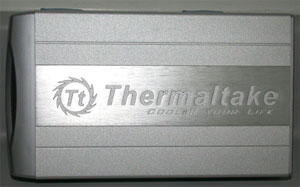|
|
|
|
|
Thermaltake SilverRiver Portable 3.5" HDD Enclosure |
|
Join the community - in the OCAU Forums!
|
Installation, Usage, Conclusions
Mounting a drive in the SilverRiver is quite simple: the case lid is removed, the 4-pin molex connector & IDE cables are connected, the drive laid in place, the lid replaced & four extra-long screws installed. The screws are longer than those used for mounting in a PC case due to 2mm thick, overlapping aluminium walls and the internal placement of the drive, so don't lose them.

The SilverRiver can be laid flat on a surface or mounted vertically in the U-shaped cradle. While stored in the cradle, the sides of the drive enclosure are gripped & held firmly by two soft, rubberised strips. When laid flat on the desk, four small rubber pads prevent direct contact between surfaces.
Connection to the PC couldn't be simpler thanks to the USB mass-storage specification (PDF here). Once the unit is connected and the power button located on the front fascia is depressed, the SilverRiver is recognised by Windows 98 SE and later as a USB2.0 drive. The disk can then be partitioned & formatted using standard MS Windows tools as if it was an internal IDE drive.
There's no one-touch-backup feature like the Maxtor portable drives offer, but I found a wonderful freeware program available that can back up all your files in as little as three clicks of a mouse button. EZBack-it-up is an incremental back-up utility, copying files directly (no compression) & maintaining directory structure even across multiple drives. EZBack-it-up has built-in scheduling and provides detailed logs for each session. As the author, Rob Decker, puts it: "no nags, no registration, just free." While the SilverRiver may not be as polished as or offer as many extras as the Maxtor OneTouch, it doesn't carry the price premium and the user gets to choose which size and model of hard drive they install.
System:
Abit NF7-S
AMD XP2800+ @ 2200MHz / 200FSB
1 GB Corsair PC3500 @ 2-2-2-11
WD 200GB WD200JB 8MB cache (IDE 0 - Disc 0)
Seagate 80GB ST380021A (IDE 0 - Disk 1)
Seagate 160GB ST3160021AS 8MB cache (SATA - Disk 2)
WD 200GB WD200JB 8MB cache (USB2.0)
Testing:
Quoted figures state a maximum rate of 480Mb/s for USB2.0, but of course, the observed data transfer rate falls well short of this due to the mechanical limitations of hard drives. File transfers yielded the following in my test setup:
Single large file: 4.35GB (4581MB)
Internal Transfer 3:23 (~22.5 MB/s)
External Write 4:10 (~18.5 MB/s - 25% slower)
External Read 4:40 (~16.5 MB/s - 38% slower)
Many small files: 4.48GB (4820MB)
Internal Transfer 4:10 (~19.5 MB/s)
External Write 5:10 (~15 MB/s - 25% slower)
External Read 5:04 (~15 MB/s - 25% slower)
With the firewall & virus-scanning turned off, CPU utilisation usually varied from 8% to 21% during transfers, averaging at around 15% in Task Manager. Maximum CPU utilisation never went above 33%. Note that this is more dependant on your USB controller and O/S than the drive caddy itself, so will vary from system to system.
Conclusions:
I expected a slow transfer rate across the USB2.0 connection, but was pleasantly surprised to find that speeds were only around 25% slower than that of the internal HDDs. In general use, transferring backup files is done in the background while carrying out other tasks (such as writing this article) so the speed difference is not all that important. For those with USB1.1, I would expect the data transfer rate to be more of a liability with transfers taking as much as 40x longer. Expect a 4.5GB transfer to take over an hour over a USB1.1 connection.
The main thrust of this exercise is portability, an obviously subjective term. Along with the SilverRiver, I purchased a carry bag produced by Maxtor for their range of external hard drives. With great happiness, I report the Maxtor bag to be eminently suitable for the SilverRiver package, with the exception of the vertical stand. The enclosure fits nicely into the main storage area which is well-padded, while two external zipped pouches hold the power brick, associated cords and the USB cable. Total weight is around 2kg and the carry bag fits easily into my backpack while still allowing room for general daily sundries such as wallet, keys, lunch, magazines, etc. I wouldn't recommend an external enclosure if you ride a bicycle or motorcycle, as most devices of this nature are not designed to protect the HDD from the shock of a 95kg computer geek (read: the author) falling upon it from a great height (not tested). For travel by train, car or bus, it's perfect.
With more PSUs coming with external molex connectors as standard, the addition of an adapter to supply power to the "PS2" power socket from a four-pin molex plug would be a significant improvement. Otherwise, I would recommend this for anyone wanting to locate their back-up storage outside their PC or those who require portable mass storage.
Total costs at time of purchase (Oct 2004):
Thermaltake USB2.0 3.5" Portable HDD Enclosure: $99 from Gamedude (QLD)
Maxtor carry bag: $9 from Gamedude
Western Digital WD200JB 200GB IDE HDD: $175 from UMart (QLD)
Pros: relatively light / plug & play / transfer speed
Cons: mains power required, affecting portability
|
|
Advertisement:
All original content copyright James Rolfe.
All rights reserved. No reproduction allowed without written permission.
Interested in advertising on OCAU? Contact us for info.
|

|


